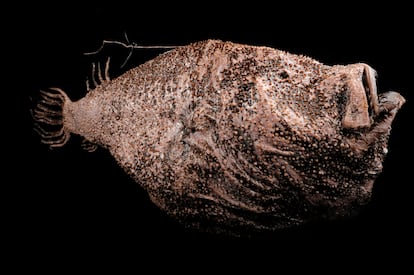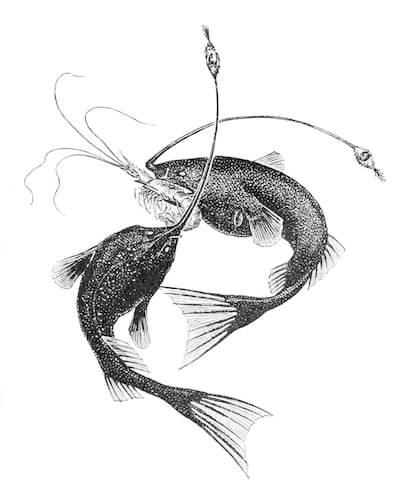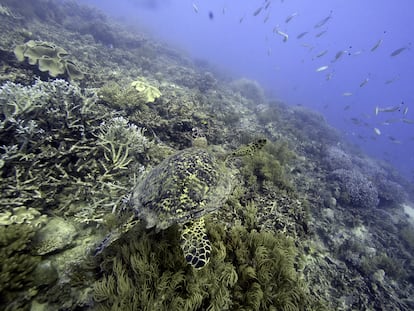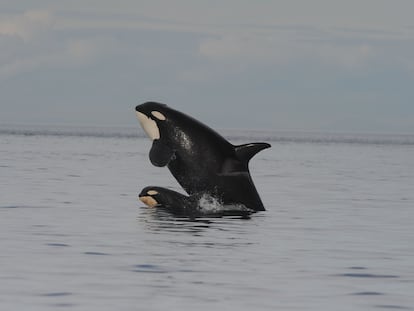Anglerfish, the amazing sexual parasites of the abyss
The study of this unique fish, whose males are born to become mere reproductive appendages of the females, could help save lives

Bjarni Saemundsson (b. 1867) was the first Icelandic biologist who devoted his life to studying fishing; he did it with no funding, whenever his job as a high school teacher allowed it. In May 1917, a very peculiar fish that appeared in the nets of a fishing boat was taken to Saemudsson for study. It was a female anglerfish of the Ceratias holboelli species. In an article published in 1922, he expressed his amazement:
“I was surprised to find that on the right side of the belly two small young ones are attached by their nose. At first sight I thought these young ones were pieces of skin. I can form no idea of how, or when, the larvae, or young, become attached to the mother. This remains a puzzle for some future researcher to solve.”
That future researcher would be Charles Tate Regan, who arrived only three years later. The specialty of this British scientist was describing and classifying fish, so it was only a matter of time before a specimen of Ceratias holboelli fell into his hands. Under its gills, Regan noticed a fish that was attached in much the same way as Saemudsson had previously described. However, upon dissecting it, he realized that those small fish were not hatchlings – they were males of the same species.
He wrote: “[The male fish is] merely an appendage of the female, and entirely dependent on her for nutrition. So perfect and complete is the union of husband and wife that one may almost be sure that their genital glands ripen simultaneously, and it is perhaps not too fanciful to think that the female may possibly be able to control the seminal discharge of the male and to ensure that it takes place at the right time for fertilization of her eggs.”
Now known as Krøyer’s deep sea anglerfish or northern seadevils, these are fish with giant, toothy mouths that live deep under the sea, at a depth of more than 1,000 feet. As you may have learned in the movie Finding Nemo, sunlight does not reach such depths, so these sea monsters use a luminous lure to attract prey. That bioluminescence is the product of a symbiotic relationship: bacteria that live in the “bulb” provide light in exchange for nutrients and protection. However, all these characteristics are unique to females, as this species has an extremely pronounced sexual dimorphism.
Ceratias holboelli females, for example, can be up to 500,000 times heavier than males. The latter lack bioluminescence, but they do have highly developed eyes and noses that allow them to locate their mate quickly, looking for both the luminous lure and a pheromone that the female secretes in abundance. Still, finding each other in the dark of the abyss is not easy, so when they do, the males give the females an eternal kiss.
This is the only known case of sexual parasitism in nature. The male secretes an enzyme that digests both his own skin and that of the female, so that their tissues and blood vessels are forever connected. Little by little, the male’s body wastes away. Its head is almost completely fused into the female’s body, losing much of its brain, eyes and even heart. At that point, it can only survive thanks to the nutrients provided by the female, and thus it is considered a parasite. Two have become one.
What the male does retain are the gonads, becoming a mere sexual appendage. In turn, the female becomes a kind of hermaphrodite with the ability to fertilize herself. It is only after the union that male and female become sexually mature.
When the young males finish their larval phase they stop eating and depend on their liver reserves to survive until they find a female; if the encounter does not take place within a few months, the young individual will die without having reached maturity, as its jaws are not able to hunt and its digestive system is not fully developed.
However, this is only the case for a few kinds of anglerfish within the wide variety that exists: among 168 species, only in 23 are the males forced to permanently join the females in order to survive. In most species the males mate only temporarily, or not at all. Curiously enough, this sexual parasitism does not have a single origin in the evolution of ceratopsids, but has occurred independently on several occasions. So, if it can happen easily and has clear advantages in reproduction, why is sexual parasitism not present in other animals?
As transplant surgeons know well, joining different bodies is not easy. By default, the immune system of any vertebrate will reject a foreign tissue. However, this does not happen among anglerfish. Females can have up to eight different males fused to their bodies and their defenses will remain neutral. Researchers have studied the reasons behind this, and in 2020 the results were published in the journal Science: in these fish, four different mutations produce a reduced immune response.
It could be that sexual parasitism drove the changes in the immune system, but the authors of the study think it is more likely the other way around: that the fact that these fish have a different immune system opened the door to sexual parasitism, something impossible in other animals. There are species, like Gigantactis vanhoeffeni, whose males do not fuse their tissues, but already show some of these genetic differences.

There is no shortage of microorganisms in the depths of the oceans. How can the anglerfish survive if they are immunosuppressed? The possibility that these fish have developed an entirely new type of immune system has not been ruled out, although something akin to a reorganization of the defenses – so that they attack pathogens, but not other individuals of their own kind – is more likely to be the answer.
These findings hold promise for the study of immunity and transplantation. It is nice to imagine that something that started in 1922, when an Icelandic biologist was surprised by a fish, could end up saving lives more than a hundred years later.
Sign up for our weekly newsletter to get more English-language news coverage from EL PAÍS USA Edition
Tu suscripción se está usando en otro dispositivo
¿Quieres añadir otro usuario a tu suscripción?
Si continúas leyendo en este dispositivo, no se podrá leer en el otro.
FlechaTu suscripción se está usando en otro dispositivo y solo puedes acceder a EL PAÍS desde un dispositivo a la vez.
Si quieres compartir tu cuenta, cambia tu suscripción a la modalidad Premium, así podrás añadir otro usuario. Cada uno accederá con su propia cuenta de email, lo que os permitirá personalizar vuestra experiencia en EL PAÍS.
¿Tienes una suscripción de empresa? Accede aquí para contratar más cuentas.
En el caso de no saber quién está usando tu cuenta, te recomendamos cambiar tu contraseña aquí.
Si decides continuar compartiendo tu cuenta, este mensaje se mostrará en tu dispositivo y en el de la otra persona que está usando tu cuenta de forma indefinida, afectando a tu experiencia de lectura. Puedes consultar aquí los términos y condiciones de la suscripción digital.
More information
Últimas noticias
Most viewed
- Reinhard Genzel, Nobel laureate in physics: ‘One-minute videos will never give you the truth’
- Oona Chaplin: ‘I told James Cameron that I was living in a treehouse and starting a permaculture project with a friend’
- Pablo Escobar’s hippos: A serious environmental problem, 40 years on
- Why we lost the habit of sleeping in two segments and how that changed our sense of time
- Charles Dubouloz, mountaineering star, retires at 36 with a farewell tour inspired by Walter Bonatti











































